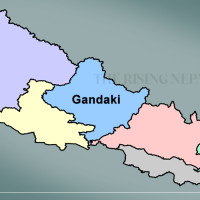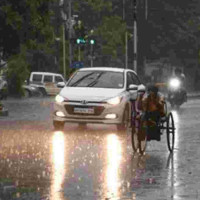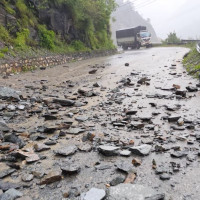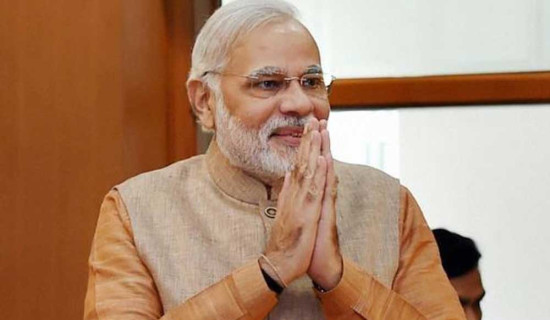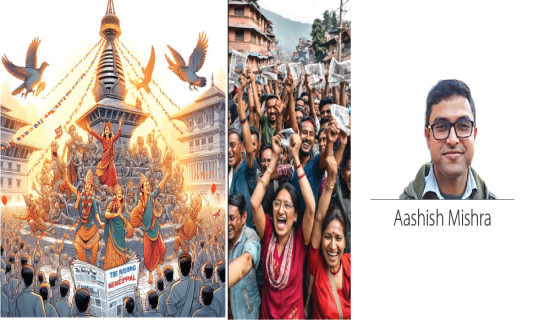- Sunday, 24 August 2025
Monuments in disarray in lack of adequate attention
Kathmandu, July 30: At the crossroads of Yangal, a five-minute walk from the UNESCO-recognised monument zone of Hanumandhoka Durbar Square, is the forsaken Yangah Hiti. This Lichhavi-era tap may once have been a marvel of water architecture. Today though, it lies submerged in its own water and covered by thick bushes to the unfamiliar eye, the Hiti looks little more than a swampy crater.
Similarly, less than a dozen steps from the north end of the Patan Durbar Square, also a world monument zone within UNESCO’s World Heritage Property, stands (but barely) the Dattatreya Temple. Not many know of this temple, perhaps that is why it has not been conserved.
As documented by a 2021 report published by this paper, almost all of the struts of the temple have been stolen, along with part of the main door’s frame. Many of the tiles covering the temple’s roofs have fallen off and the walls have cracked. The 2015 earthquake has caused the whole building to tilt to the south. The stone statue of the Garuda erected on a pillar in front of the temple was also stolen and had to be replaced with a replica.
Meanwhile, the Hari Shankar Temple southwest of the palace building at Bhaktapur Durbar Square looks structurally sound. It completed reconstruction in 2018 and does not show signs of damage. But locals said that almost all the traditions that made this place of worship a sacred temple had disappeared. It remains closed for most of the year and even the daily rituals have ceased to be performed.
“We live in a country where almost every alley and every building is a heritage. But monuments outside of the UNESCO World Heritage Sites do not seem to fall on our radar,” Suresh Shakya, a tourist guide in Patan, acknowledged. “As a result, they are neither protected nor promoted.”
Shakya gave the example of Kathmandu Valley’s River Ghats. “There are temples and buildings there that date back millennia. Yet, many are lying derelict. We [tour guides] do not take tourists there. People and the government only think of them as cremation grounds. Our Ghats have not been bestowed the honorific title of ‘Heritage’ and many are vanishing under pressures of ‘development’ and settlement expansion.”
Those holding the title are not much better off either. The 60th annual report of the Office of the Auditor General presented to the President in April this year noted that archaeologically significant artefacts and heritage sites, including the 4,850 registered as ‘ancient monuments’ by the Department of Archaeology (DoA), have not been adequately protected.
It chides, “[The state] has not achieved expected progress in conserving monuments because of a lack of policy and regulations that foster coordination between the federal, provincial and local governments, insufficient budget, shortage of traditional building materials and skilled human resource, and increasing encroachment.”
Conservation on even the World Heritage Sites that, in Shakya’s words, are “always on our radar” leaves much to be desired. The Pashupati Area Development Trust (PADT), which manages the Pashupatinath Temple complex that was inscribed on UNESCO’s World Heritage list in 1979, regularly courts controversy for its treatment of monuments there.
Including what is arguably Nepal’s most popular Hindu temple, the Trust oversees 500 structures like temples, shelters, Chaityas, water spouts and shrines and around 1,000 Shiva Lingas spread over 264 hectares of land. But its handling of these priceless treasures invites disputes.
The Trust has been accused of using concrete haphazardly, violating national and international principles of conservation, mismanagement of its property, dereliction of duty and working without consultation with and confidence of stakeholders. Its installation of the golden Jalahari receptacle in the sanctum sanctorum of the main Pashupati temple prompted an on-going investigation by the Commission for the Investigation of Abuse of Authority (CIAA).
The masterplan the PADT proposed in 2020 also ignited fierce opposition as it sought to evict over 200 households, pool private land and relocate the Arya Ghat, all things experts argued would disconnect Pashupatinath from society and living culture, damage the intangible traditions it stands on and destroy its antiquity.
In Swoyambhu, which was declared a world heritage the same year as Pashupati, the Chaityas and statues in the western face of the hillock were indiscriminately painted with enamel four years ago. History and culture scholar and author Basanta Maharjan wrote an article opposing it at the time.
Talking to The Rising Nepal this week, Maharjan shared that such painting damaged the ancient structures in many ways. “First, the chemicals they contain damage the artefacts they cover,” he said.
He added, “Second, they conceal the fine details and artworks of the monuments.”
Such painting is rampant in Kathmandu Valley and Maharjan wanted people to know that it was wrong. “Heritage is also a display of craftsmanship. Burying it under a layer of possibly harmful paint benefits no one.”
But why, in our country known for its culture and heritage, are cultural heritages shown such insensitivity? Maharjan felt it was because of a lack of public awareness. “How many of us are truly aware of heritage and conservation?” he questioned.
Heritage activist and advocate Sanjay Adhikari also believed it was due to a lack of implementation of existing laws. Articles 16 (right to live with dignity), 25 (right relating to property) and 26 (right to freedom of religion) of the Constitution of Nepal cannot be fully realised without the maintenance of tangible and intangible heritage, he said.
Likewise, Article 48 (D) requires all citizens to protect and preserve public property, and this includes historic monuments, Adhikari explained. Sub-clause 8 of Article 51 (J) requires the state to seek the participation of indigenous nationalities in decisions concerning their communities by making special provisions for opportunities and benefits to ensure their right to live with dignity, along with their identity, and protect and promote traditional knowledge, skill, culture, social tradition and experience.
Additionally, we also have the Ancient Monument Preservation Act 1956, Environment Protection Act 2019 and the National Culture Policy which all govern monuments and their utilisation and protection. The Guthi Corporation Act of 1976 seeks to preserve intangible customs and traditions maintained by the Guthis, lawyer Adhikari elucidated. The trusts and funds overseeing areas of considerable cultural and religious significance, including the PADT, Lumbini Development Trust (LDT) and Greater Janakpur Area Development Council, have their own acts.
Moreover, Nepal is also a signatory to multiple international conventions regarding heritage preservation like the UNESCO 1970 convention on the means of prohibiting and preventing the illicit import, export and transfer of ownership of cultural property and the 2003 convention for safeguarding the intangible cultural heritage.
“We have laws. What we don’t have is their implementation,” Adhikari said.
Also, he stated that the DoA, the principal organisation for the study and preservation of Nepal’s
cultural heritage, was underfunded and overworked. “The Department lacks the budget and resources to build up capacity. And its work has not yet been decentralised as per the federal setup of the country.”
Ramesh Raj Paudel, information officer at the DoA, said that the Department currently worked with local and regional stakeholders to ensure that the nation’s monuments were well taken care of.
“As a whole, all monuments in Nepal fall under our jurisdiction. But they may also be under the care of community groups (Guthis), preservation trusts or the local governments. So, we coordinate with them to carry out preservation and management works,” he mentioned.
Paudel also informed that the DoA took reports of damage or destruction of heritages seriously and that all complaints registered at the Department were handled by the relevant section.
But he, like Maharjan, said that the problem was a lack of proper public understanding. “Everyone must realise that heritage belongs to all of us and we must protect it.”
Similar to this, Professor Dr. Madan Rimal, former head of the Department of Nepalese History, Culture and Archaeology at Tribhuvan University, opined that the local people and local governments needed to be at the forefront of conservation. “The residents of an area are the first to know of problems and can call attention to heritage neglect and damage. Government officials, unfortunately, cannot be everywhere.”
He added, “Local governments can also take initiatives. They can work with communities to safeguard artefacts and historical sites and must also be active in commissioning research and documentation.”
Meanwhile, Adhikari felt that trusts like PADT and LDT also needed to be restructured. PADT, in particular, was formed by the former royals to build up the wealth of the temple, he said. “We need to ask ourselves now whether we need our temples to be wealthy or prosperous and respectful of our civilisation.”
The Rising Nepal tried reaching out to the Culture Division of the Ministry of Culture, Tourism and Civil Aviation to understand what the ministry is doing to preserve Nepal’s heritage, promote cooperation and collaboration among government agencies and make its subordinate bodies more efficient and sensitive. However, Joint Secretary Dr. Suresh Suras Shrestha, who leads it, was out of the country.




